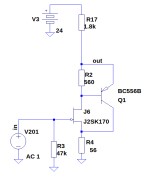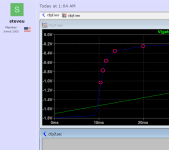Those 'dynamics' are very much superimposed, or better, modulated upon the static setpoint. I've another opinion about this, but granted.Dynamically irrelevant.
Right so, as I was aiming at another goal:that the combination seems to be noticeably more linear than the FET alone.
How to convert the old ECC83 circuits into modern solid state versions?
Reducing 200V supplies to 20V involve some adjustments to other settings - the Gm (ECC83 / 12AX7 = 1.6 mA/V - Ra =63k - mu =100) projects the bf245 & bc560 combo into another scenario: how to lift the bf245 gain of a mere approx 4.4mA/V (median value) into the wanted 16 mA/V? The shift is a tenfold, and a transconductance amplifier is required here thus.
If you add the LTSPICE directive
that will give you much higher resolution on your dIout / dVin plot; twenty plotted points per 10 milliseconds of horizontal grid
.OPTIONS MAXSTEP=0.5m
that will give you much higher resolution on your dIout / dVin plot; twenty plotted points per 10 milliseconds of horizontal grid
My maxstep is 1/(1000*Freq)= 1us for Freq=1k
_
Attachments
I agree, and is a good tool for the analog EEs toolbox.This is my old RIAA amplifier input stage. It is in fact quite a good amplifier stage...
It is very close to the same circuit used as the gain element in each of the 4 compressors in a DolbyA unit. Back when I was working on modeling the DolbyA NR, I was a little surprised at the low amount of Id current on that specific circuit (approx 0.04ma). I ended up being reassured after doing the Spice model of that subcircuit, I was pleasantly surprised at the well constrained distortion and useful freq response. My 'prejudice' would be to typically use an Id current of something greater than 0.1ma. The purpose of that version of the 'good amplifier stage' is to provide the forward gain for a feedback compressor. Unfortunately, the schematic that I am referring to specifies one of the important resistors as 'AOT' as a selected component, but AFAIR the gain provided is either approx 10 or 11. R Dolby probably designed the circuit back before approx 1971, the date on the schematic.
There are some real geniuses who originated certain circuit designs, and a lot of historical technical reports and circuit designs where interesting things can still be learned. I have been quite impressed when looking at R Dolby's public, proprietary designs, and his patents (along with the likes of Orban) can be very interesting. It can be a learning experience to 'trawl' old designs, sometimes the designs can be enlightening, very similar to reading postings like and others on diyAudio.
John
- Home
- Design & Build
- Electronic Design
- Sziklai Transconductance calculation... ahum?

